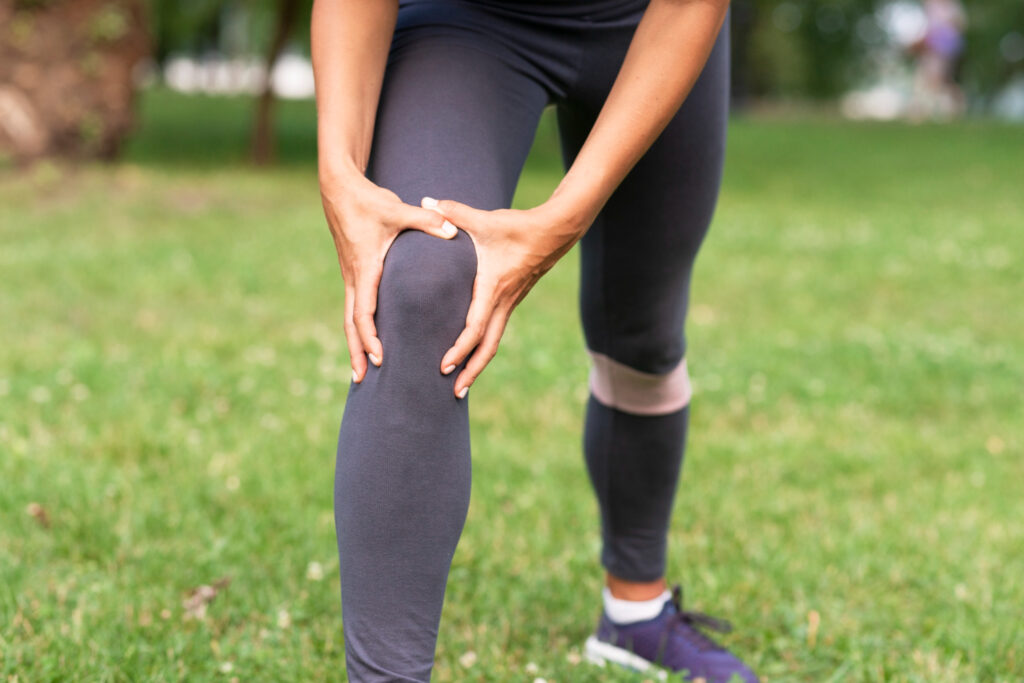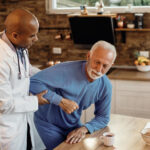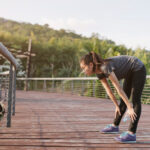
Experiencing mild knee pain or discomfort after a workout is common, but if it becomes persistent, it could indicate a more serious problem. Several potential causes include ligament tears, osteoarthritis, and runner’s knee. The appropriate treatment will depend on your diagnosis
The knee is a complex joint involving bones, ligaments, menisci, muscles, and tendons that all support the joint. Damage or stress to any of these components can cause achy knees. Many physical activities, such as bending, jumping, running, and stretching, can strain your knees, leading to pain during or after workouts.
Knee pain is a common exercise complaint, affecting about 25% of adults. Read on to learn about the common causes of knee pain and how to treat it.
Bursitis
Bursitis causes pain in the front of your knee if a bursa becomes irritated and swollen. A bursa is a fluid-filled sac that cushions and protects your bones, muscles, and tendons.
Causes
- Injury
- Overuse
- Repeated pressure, such as kneeling
- Changes in activity level (e.g., training for a marathon)
- Infections
- Some types of arthritis
Symptoms
- Pain and tenderness when you press on your knee
- Pain around your knee
- Pain while moving and resting
- Redness, swelling, or warmth
- Stiffness while moving
Iliotibial Band Friction Syndrome (ITBFS)
ITBFS is an overuse injury where the iliotibial (IT) band, a tendon along the outside of your leg, rubs against the bone, typically when you bend. This causes the IT band to become irritated and swollen, resulting in pain in the lateral (outer) knee.
Commonly Affects
- Basketball, hockey, or soccer players
- Cyclists
- Long-distance runners
- Skiers
Symptoms
- Pain that starts when you begin exercising and improves as you warm up
- Pain that worsens as ITBFS progresses, even after warming up
- Increased pain when bending your knee while sitting or running downhill
Jumper’s Knee
Jumper’s knee, also known as patellar tendinitis, patellar tendonitis, or patellar tendinopathy, is a knee joint injury resulting from strenuous jumping activities, often seen in basketball or volleyball players. Long-distance running and skiing can also lead to jumper’s knee.
Commonly Affects
- Athletes aged 15–30
Symptoms
- Pain below the kneecap
- Stiff knees while climbing stairs, jumping, and kneeling
- Pain-free when resting
Ligament Tears
Ligaments are tissues that connect bones. The anterior cruciate ligament (ACL) and medial collateral ligament (MCL) are two commonly injured ligaments in the knee. The ACL runs in the middle of the knee, while the MCL, located on the inner knee, prevents it from bending inward. Other ligaments that can tear include the posterior cruciate ligament (PCL) and lateral collateral ligament (LCL).
Symptoms
- A loud popping sound at the time of injury
- Feeling unstable, especially if you have an MCL tear
- Pain
- Swelling, typically within six hours of an ACL injury
Meniscus Tears
The meniscus is a cushion of cartilage in your knee that absorbs shock. A meniscus can tear from kneeling, squatting while lifting something heavy, or twisting the knee. Injuries from getting hit and quickly changing directions can also cause a meniscus tear.
Symptoms
- Locking of the knee
- Pain that worsens with pressure or walking
- Swelling the day after the injury
Osteoarthritis
Knee osteoarthritis (OA) occurs when wear and tear break down joint cartilage. OA, often resulting from overuse, is one of the most common diseases affecting the knees, typically developing with age. OA affects more than 32.5 million adults in the United States.
Symptoms
- Pain worsened by long-term OA, inactivity, or prolonged movement
- Repetitive bending or stair use
- Changes that limit motion, cause stiffness, and swelling
- Buckling knees and a grinding or scraping noise while walking
Runner’s Knee
Runner’s knee, or patellofemoral pain syndrome (PFPS), is an overuse injury affecting the knee joint, often causing a tender or grating sensation. Pain may worsen after climbing stairs, getting up from a chair, running, sitting for long periods, and squatting.
Commonly Affects
- About 13% to 30% of runners
Causes
- Changes in running mileage or speed
- Increased hill training
- Surgery or trauma to the knee
- Poor nutrition, sleep, and stress
Strains and Sprains
Strains, or pulled muscles, and sprains, which are ligament injuries, result from abrupt and unnatural twisting of muscles.
Causes of Strains
- Excessive physical activity
- Improper warm-up before exercise
- Poor flexibility
Symptoms
- Bruising or discoloration of the skin
- Difficulty moving the muscle
- Joint stiffness
- Pain
- Swelling
Infection
Infectious arthritis occurs if bacterial, viral, or fungal infections from other parts of the body spread to the knees. Reactive arthritis happens when your joints react to an infection elsewhere in the body, such as a urinary tract infection (UTI) or vaginal infection.
Symptoms
- Knee pain
- Chills
- Difficulty moving the affected joint
- Fever
- Red, swollen joints
Dislocated Kneecaps
Dislocating your kneecap can result from awkward twists or bumps. Adolescents most commonly experience dislocated kneecaps from sports.
Symptoms:
- A popping sound when the injury occurs
- Extreme pain
- Visible dislocation of the kneecap
Fractured Kneecaps
Although uncommon, car accidents or falls can fracture the kneecap, causing pain near the front of the knees.
Symptoms
- A build-up of fluid in the affected area
- Feeling unstable
- Tenderness to the touch
- Trouble climbing stairs
- Weakness
Home Remedies for Knee Pain
For non-severe knee pain, home remedies include:
- Resting
- Applying ice
- Keeping your knee raised
- Wearing an elastic bandage or sleeve
- Taking over-the-counter (OTC) pain relievers like NSAIDs
When to See a Healthcare Provider
Consult a healthcare provider if you have severe knee pain or other concerning symptoms, such as:
- Buckling, clicking, or locking
- Deformity or changes in shape
- Fever, redness, or warmth with swelling
- Pain after three days of at-home treatment
- Trouble flexing or straightening your knee
Treatments for severe knee pain may include steroid injections, physical therapy, or surgery.











